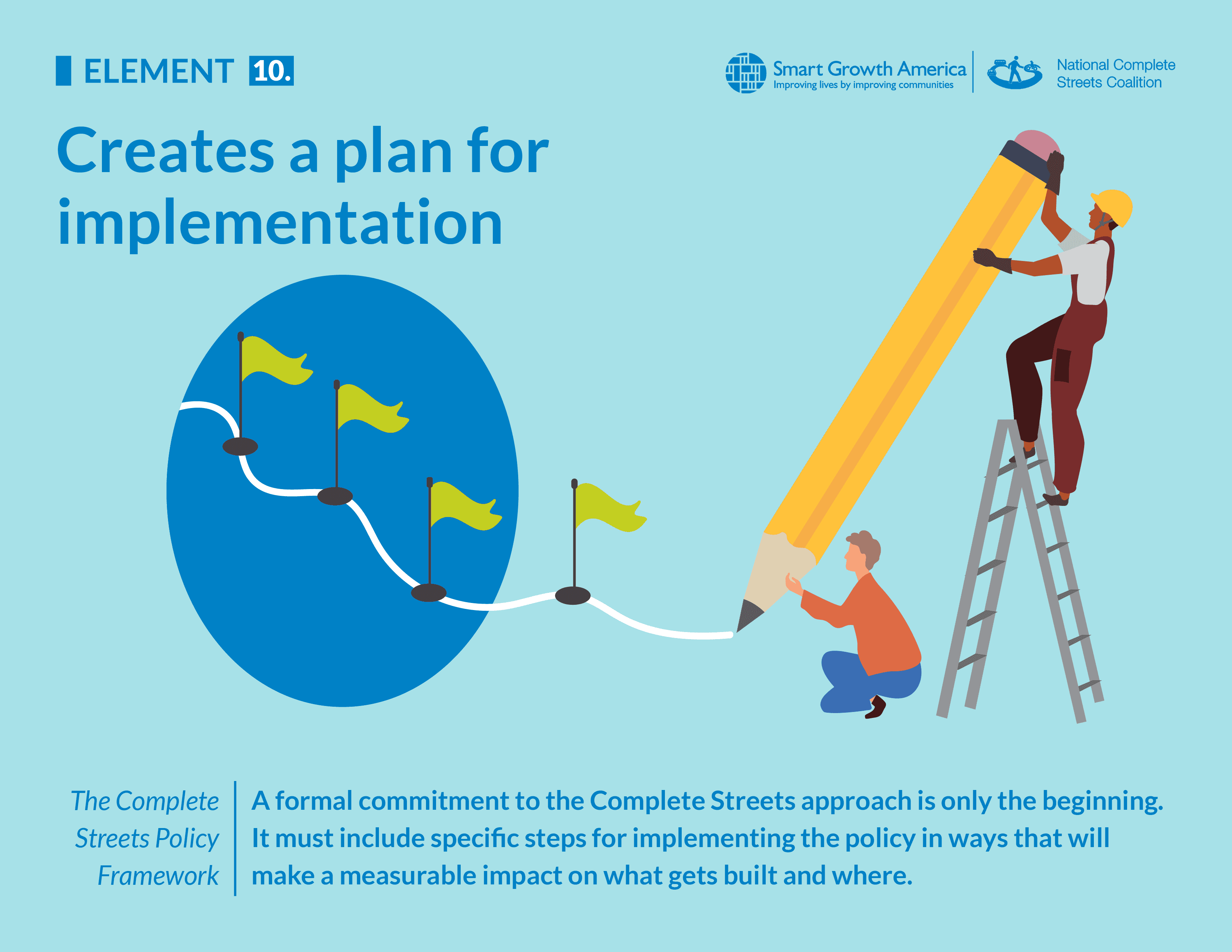
News
By Steve Davis, April 24, 2023
A formal commitment to a Complete Streets approach is just the beginning. A strong policy also spells out specific steps for implementing the policy in ways that will make a measurable impact on what gets built and where.

Why is this element integral to a strong Complete Streets policy?
Over the last decade, we’ve come to understand that a Complete Streets policy is only the first step to making streets safer and more accessible to everyone. The strongest policies often represent a massive paradigm shift from the current practices, agency processes, and standards that have been producing unsafe, incomplete, inaccessible, and unproductive streets. And so they must also include a clear plan for how an agency will go about putting the policy into practice.
We have seen policies in the past that are clear and strong in nearly every area, yet fail to produce the desired impact because there was no plan, checklist, or entity in charge of institutionalizing the policy and putting it into practice. (If everyone is responsible, then no one is responsible.) These missing components make it difficult (or impossible) to ensure professional staff is trained, stakeholders are held accountable, processes are updated, and the public is equitably engaged.
And so achieving a Complete Streets policy’s ambitious goals requires this tenth and final element: A clear, measurable, accountable plan for thorough and thoughtful implementation. While “implementation” was included in the National Complete Streets Coalition’s pre-2018 policy framework, it was revised to set the bar far higher and provide clearer guidelines, including increased accountability from jurisdictions and requirements to include equity and community engagement.
What does this element look like in practice?
To produce different outcomes when it comes to designing and building streets, departments of transportation must change the way they operate, including changes to their project development process, design guidelines, and performance measures. This is most successfully done through training, education, and strong leadership. Jurisdictions should include language and actionable steps for implementation in their Complete Streets policy. Implementation steps are worth the most points out of all of the policy elements, as they lay out specific next steps for putting the policy into practice.
Unlike the other nine elements, based on our long experience and hard-won knowledge borne of real-world experience in scores of communities, this element is a little more prescriptive. These five short steps—to be embedded in the policy itself—provide an actionable checklist for implementing a new, strong Complete Streets policy:
1. Restructure or revise related procedures, plans, regulations, and other processes to accommodate all users on every project. This could include incorporating Complete Streets checklists or other tools into decision-making processes.
2. Develop new design policies and guides or revise existing policies to reflect the current state of best practices in transportation design. Communities may also elect to adopt national or state-level recognized design guidance.
3. Offer workshops and other training opportunities to transportation staff, community leaders, and the general public.
4. Create a committee to oversee implementation. The committee should include both external and internal stakeholders as well as representatives from advocacy groups, underinvested communities, and vulnerable populations such as people of color, older adults, children, low-income communities, non-native English speakers, those who do not own or cannot access a car, and those living with disabilities.
5. Create a community engagement plan that considers equity by targeting advocacy organizations and underrepresented communities which could include non-native English speakers, people with disabilities, etc. depending on the local context.
Policy scoring details
In our framework for evaluating and scoring Complete Streets policies, this element is worth a total of 15 out of 100 possible points, the single most valuable element, precisely because putting the policy into practice is so crucial to success.
- 3 points: The policy requires that related procedures, plans, regulations, and other processes be revised within a specified time frame.
- (1 point) The policy mentions revising procedures, plans, regulations, and other processes.
- (0 points) No mention.
- 3 points: The policy requires workshops or other training opportunities for transportation staff. The policy is specific about the timing and/or staff members for the training and workshops.
- (1 point) Policy mentions workshops or other training opportunities for transportation staff.
- (0 points) No mention.
- 3 points: The policy assigns responsibility for implementation to a new or existing 15 committee that includes both internal and external stakeholders that are representative of underinvested and vulnerable communities. The policy is specific about which internal and external stakeholders are/will be represented on the committee.
- (1 point) Policy assigns oversight of implementation to a specific body that may not include both internal and external stakeholders.
- (0 points) No mention.
- 6 points: The policy creates a community engagement plan with specific strategies for who, when, and how they will approach public engagement in the project selection, design, and implementation process. The policy specifically addresses how the jurisdiction will overcome barriers to engagement for underrepresented communities.
- (3 points) Policy creates a community engagement plan with specific strategies for who, when, and how they will approach public engagement but does not address underrepresented communities.
- (1 point) Policy mentions community engagement but does not go into detail about specific strategies.
- (0 points) No mention.
Related News

© 2025 Smart Growth America. All rights reserved
Site By3Lane Marketing

















